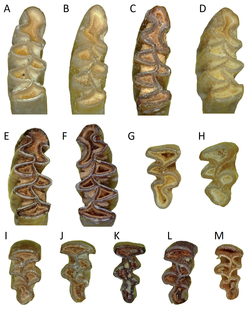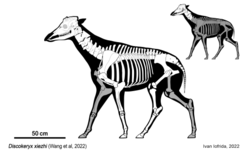Afrotherians
Proboscidea
| Name | Novelty | Status | Authors | Age | Type locality | Country | Notes | Images |
|---|---|---|---|---|---|---|---|---|
Sp. nov | Valid | Wang & Li | Tunggur Formation | |||||
Sp. nov | Valid | Miocene | ||||||
Proboscidean research
- A study on the landscape-scale patterns in diet of mammoths and mastodons is published by Pardi & DeSantis (2022), who report evidence indicating that mammoths had significant dietary preferences for grass, but also engaged in more mixed-feeding in the areas outside the most environmentally suitable parts of their distribution, while the dietary preferences for mastodons were less resolved. [3]
- Partial skeleton of a specimen of "Mammut" borsoni , representing one of the most recent record of mammutids in Europe reported to date, is described from the Villafranchian of Kaltensundheim (Thuringia, Germany) by Koenigswald et al. (2022). [4]
- A study on patterns of landscape use by "Buesching mastodon" (recovered in 1998 from a peat farm near Fort Wayne, Indiana, United States) during its life is published by Miller et al. (2022), who interpret their findings as indicative of shifts in landscape use by this individual during adolescence and following maturation to adulthood, including increased monthly movements and development of a summer-only range and mating ground. [5]
- A study on the carbon and oxygen isotope ratios in teeth of a sub-adult mastodon found in southern Brazil is published by Lopes et al. (2022), who interpret their findings as indicative of a diet shift during the life of the animal, and indicating that mastodons were able to change their diets at shorter timescales than can be addressed from the analysis of isolated teeth. [6]
- Fossil material of a member or a relative of the genus Sinomastodon is described from the Quaternary of the Kashmir Valley by Parray et al. (2022), representing the youngest record of a gomphothere from the Indian Subcontinent reported to date. [7]
- A study on the osteological anomalies in the vertebrae of Notiomastodon platensis from a new late Pleistocene site at Anolaima (Cundinamarca, Colombia) is published by Zorro-Luján et al. (2022), who interpret the studied anomalies as the result of nutritional deficiencies in essential minerals, caused by environmental stresses which were possibly related to the late Pleistocene environmental instability. [8]
- Mothé et al. (2022) describe new fossil material of Notiomastodon platensis from three Pleistocene sites in the Valle del Cauca Department (Colombia), and interpret the distribution of the fossil material of N. platensis as indicating that this proboscidean used the inter-Andean valleys as migratory corridors, avoiding more prominent Andean hills. [9]
- A study on the origin, dispersal and ecology of gomphotheres in South America is published by Alberdi & Prado (2022). [10]
- Evidence indicating that the shovel-tusked gomphotheres from Florida ( Amebelodon floridanus, Konobelodon britti, Serbelodon barbourensis) were leaf browsers that also ingested bark and twigs, using their upper tusks for scraping and slicing and their lower tusks for shoveling substrate (S. barbourensis and K. britti) or stripping and scraping (A. floridanus), is presented by Semprebon, Pirlo & Dudek (2022). [11]
- A study on the range of size variation in palaeoloxodont elephants from Sicily, Favignana and Malta, inhabiting the Siculo-Maltese Palaeoarchipelago during the Pleistocene, and on possible reasons for size differences of these elephants is published by Scarborough (2022). [12]
- A study on the morphological variation of samples of steppe mammoth and woolly mammoth remains, focusing on ca. 240,000-126,000 samples from Britain and the adjacent continent, is published by Lister (2022), providing evidence of a complex pattern of change in the transition from the steppe mammoth to the woolly mammoth in Europe. [13]
- Evidence from woolly mammoth genomes (including genomes of two new Siberian specimens), indicating that genomic insertions and large deletions likely contributed to adaptive phenotypic evolution of the woolly mammoths, is presented by van der Valk et al. (2022). [14]
Sirenia
| Name | Novelty | Status | Authors | Age | Type locality | Country | Notes | Images |
|---|---|---|---|---|---|---|---|---|
Gen. et sp. nov | In press | Zouhri, Zalmout & Gingerich | Late Eocene | Samlat Formation | A member of the family Protosirenidae. The type species is D. marocensis. | |||
Sirenian research
- A study on the phylogenetic relationships and evolutionary history of extant and fossil sirenians is published by Heritage & Seiffert (2022). [16]
- Description of the anatomy of the skull of Sobrarbesiren cardieli and a study on the affinities of this taxon is published by Díaz-Berenguer et al. (2022). [17]









